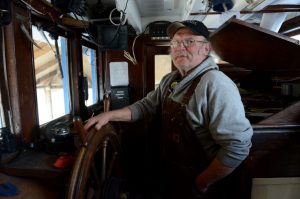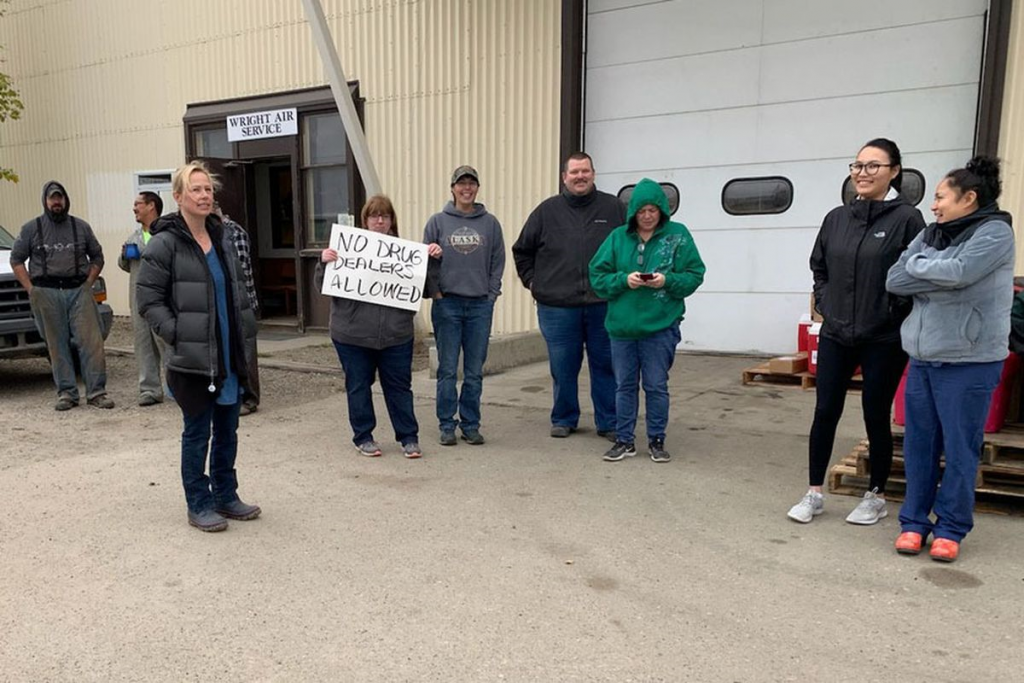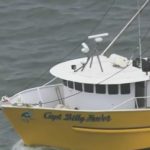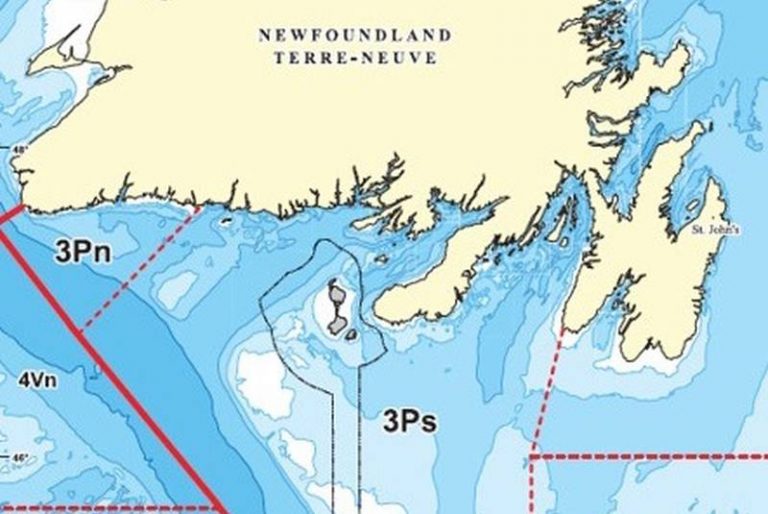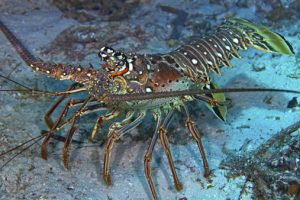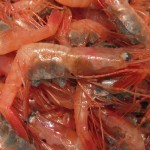Tag Archives: salmon
Alaska salmon season a success in global market
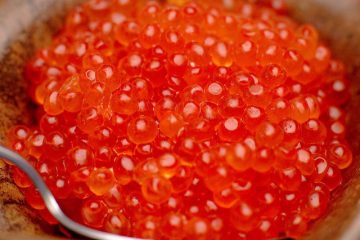 It was a generally good salmon season for Alaska, except for one species. “It was a disastrous year for chinook harvest.” That’s Andy Wink, a seafood economist with the consulting firm McDowell Group. Wink says while king salmon may be the most famous salmon species among Alaskans, it also makes up the lowest total value of all the different commercial salmon species. “Sockeye, pink salmon, chum salmon, those are the species that for the commercial fleet really move the needle in terms of total value.” click here to read the story 19:25
It was a generally good salmon season for Alaska, except for one species. “It was a disastrous year for chinook harvest.” That’s Andy Wink, a seafood economist with the consulting firm McDowell Group. Wink says while king salmon may be the most famous salmon species among Alaskans, it also makes up the lowest total value of all the different commercial salmon species. “Sockeye, pink salmon, chum salmon, those are the species that for the commercial fleet really move the needle in terms of total value.” click here to read the story 19:25
Declared unfit for human or animal consumption – Eighty tons of contested Bristol Bay salmon trashed in Anchorage landfill
 Some 158,318 pounds of highly contested Bristol Bay salmon from the F/V Akutan have reached their final destination: the Anchorage landfill. This summer, the custom processor was supposed to process up to 100,000 pounds of salmon a day for Bristol Bay Seafoods LLC, a small group of fishermen. But nearly everything that could go wrong did. The vessel’s owner went broke, the crew wasn’t paid, and when 158,318 pounds of fish came off the boat in early September, the third-party testing group NSF declared it unfit for human or animal consumption. click here to read the story 09:17
Some 158,318 pounds of highly contested Bristol Bay salmon from the F/V Akutan have reached their final destination: the Anchorage landfill. This summer, the custom processor was supposed to process up to 100,000 pounds of salmon a day for Bristol Bay Seafoods LLC, a small group of fishermen. But nearly everything that could go wrong did. The vessel’s owner went broke, the crew wasn’t paid, and when 158,318 pounds of fish came off the boat in early September, the third-party testing group NSF declared it unfit for human or animal consumption. click here to read the story 09:17
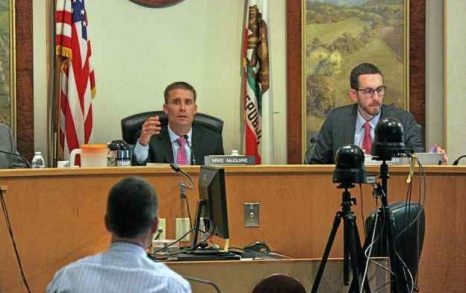
‘Time is of the essence’: California Fisheries face uncertainty
State regulators and fishing officials said at a Eureka hearing on Friday that only by working together can they overcome the trials and uncertainty that several California’s fisheries face today. With a poor salmon catch in 2017 and 2016 and a potential delay in the North Coast Dungeness crab season following three years of poor landings and abnormal ocean conditions, Pacific Coast Federation of Fishermen’s Associations Executive Director Noah Oppenheim said fishing fleets are still feeling the economic effects and that time to address the underlying issues is running slim. click here to read the story 08:46
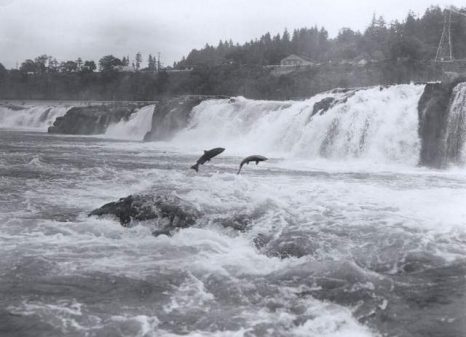
Salmon in the history of the Pacific Northwest
Lewis and Clark’s interpreter and guide Sacagawea was a “Salmon Eater.” That’s what they called her tribe of Lemhi Shoshone Native Americans, a nomadic band who lived in Idaho’s Lemhi River Valley and along the upper Salmon River — their descendants today living mostly on the Fort Hall Indian Reservation near Pocatello. Sacagawea’s tribe was made up of the Agaidikas or Salmon-Eater Shoshone and the Tukidikas. Sacagawea belonged to the Agaidikas. Food was almost always a big challenge for Lewis and Clark’s Corps of Discovery expedition. click here to read the story 19:43
2017 Commercial Salmon Harvest Summary
 The Alaska Department of Fish and Game (ADF&G) has compiled preliminary harvest and value figures for the 2017 Alaska commercial salmon fishery (PDF 130 kB). Although there are still fish being caught, the majority of 2017 salmon fisheries have ended. The 2017 commercial salmon fishery all species harvest was 224.6 million wild salmon with an estimated preliminary exvessel value of $678.8, a 66.7% increase from 2016’s value of $407.3 million. Of this total, sockeye salmon again came in as the most valuable species, accounting for 48% of the value at $326.1 million and 23% of the harvest at 52.4 million fish. click here to read the press release 14:56
The Alaska Department of Fish and Game (ADF&G) has compiled preliminary harvest and value figures for the 2017 Alaska commercial salmon fishery (PDF 130 kB). Although there are still fish being caught, the majority of 2017 salmon fisheries have ended. The 2017 commercial salmon fishery all species harvest was 224.6 million wild salmon with an estimated preliminary exvessel value of $678.8, a 66.7% increase from 2016’s value of $407.3 million. Of this total, sockeye salmon again came in as the most valuable species, accounting for 48% of the value at $326.1 million and 23% of the harvest at 52.4 million fish. click here to read the press release 14:56
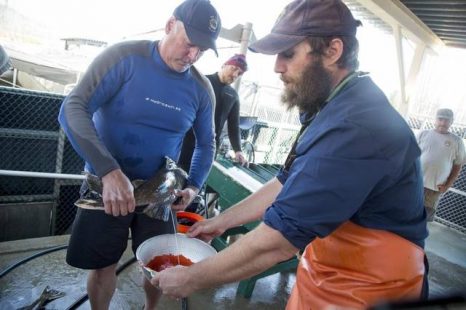
Do humans have it wrong? Treating salmon as commodity may threaten their wild existence
As once-uncountable Northwest salmon stocks have dwindled, humans have tried a number of remedies to bolster or replace the disappearing fish. We’ve caught them at dams and trucked and barged them past obstacles. When the fish return home, we strip them of their eggs, fertilize them in buckets and grow new generations of baby salmon in hatchery raceways. But what if humans have it all wrong? What if those efforts are not just not working, but actually reducing the salmon’s odds of survival? What if hatchery fish do more than just dilute the genetic fitness of the wild, native salmon that evolved to live and spawn in particular conditions in specific stretches of individual streams? click here to read the story 16:00
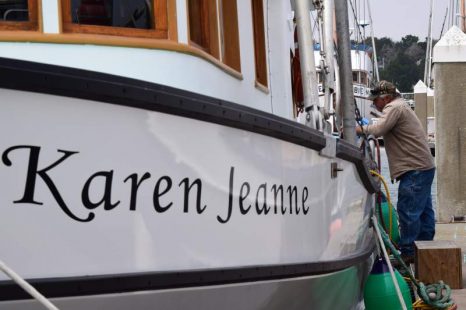
Drought years cut North Coast salmon population
Soon after the commercial salmon season opened on Aug. 1, Chris Lawson steered his 53-foot boat named Seaward out of the marina at Bodega Bay into ocean waters where he figured chinook salmon would travel. He spent the day trolling, his lines carefully prepared to entice the spirited, iridescent fish. There were plenty of salmon, but mostly two-year-olds too small for a commercial fisherman to keep. Lawson shook off nearly 100 short fish from his lines and kept just seven longer than the minimum size — 27 inches. He snagged $9 a pound for 63 pounds, yielding $567 for the day’s work before fuel expenses and pay to one crew member, who gets 20 percent.,, “Seven hours, we had seven fish,” Lawson said. “You make a little bit of money. There were a lot of short fish,” said Lawson, interviewed alongside his boat on Aug. 10. “It looks better for next year. Recreational guys are having an OK season.” Their size limit is smaller. click here to read the story 14:43
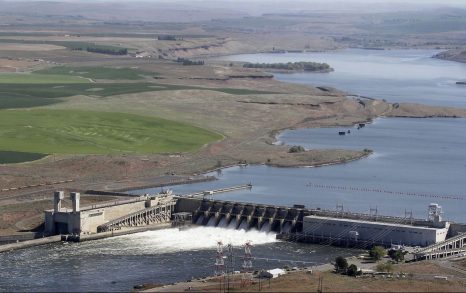
Trump administration urged to avoid salmon protection rules
A group that represents farmers is calling the costs of saving imperiled salmon in the largest river system in the Pacific Northwest unsustainable and is turning to the Trump administration to sidestep endangered species laws. The Columbia-Snake River Irrigators Association wants the government to convene a Cabinet-level committee with the power to allow exemptions to the Endangered Species Act. The irrigators association is frustrated with court rulings it says favor fish over people, claiming the committee could end years of legal challenges over U.S. dams on the Columbia and Snake rivers and bring stability for irrigators, power generators and other businesses that rely on the water. click here to read the story 18:12

Commercial salmon season finally arrives in the Bay Area
At Monterey Fish Market on Pier 33, one San Francisco fisherman alone brought in 300 pounds of salmon on Tuesday, the first day of the Bay Area commercial salmon season. That haul was, in co-owner Tom Worthington’s words, a good omen for the much-delayed start of the season. Yet it’s still too early to say what the rest of the season, which wraps up Sept. 30, will bring.,,, According to Larry Collins of the San Francisco Community Fishing Association, the larger fishing boats he works with report getting 20 to 50 medium-size fish a day. Most boats won’t come back for a few more days, so salmon probably won’t start showing up in the markets until the weekend. Those on the water reported calm seas and low winds. click here to read the story 08:23
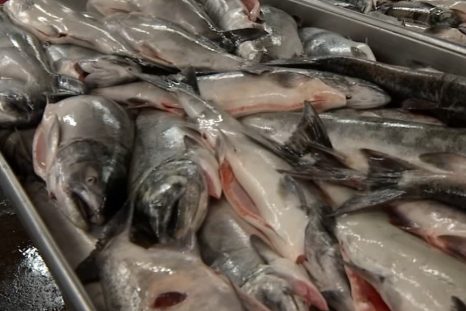
Limited salmon numbers, sea lion population making tough season for fishermen
Governor Brown, along with Governor Jerry Brown of California, recently submitted a request to U.S. Commerce Secretary Wilbur Ross for a declaration of a “catastrophic regional fishery disaster,” and a commercial fishery failure. The request comes after the National Marine Fisheries Service closed the southern half of the Oregon coast to commercial salmon fishing to protect dwindling stocks of Chinook salmon on the Klamath River. “When you look at the Klamath situation, it affects fisheries all up and down the coast,” said Steve Fick, who owns Fishhawk Fisheries in Astoria. Executive Director of the Port of Astoria Jim Knight said the south coast closure will likely mean more fishing boats competing for limited numbers of salmon on the north coast. click here to read the story 08:09
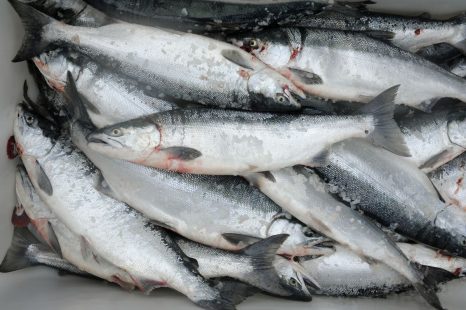
Copper River salmon return may not be huge, but at least they’re en route
After a long hard winter, Alaska’s commercial salmon fishing season officially gets underway in less than two weeks. The first big fishery for sockeye and king salmon is set for May 18 at Copper River, and the town of Cordova is buzzing, said Christa Hoover, executive director of the Copper River/Prince William Sound Marketing Association. “The mood changes at the start of May with all the folks back in town and boats going in and out of the water,” she said. Enthusiasm among the fleet of more than 500 drift gillnetters has not been dampened by a reduced harvest projection. Fishery managers expect a Copper River salmon catch this season of just 889,000 sockeyes, 4,000 kings and 207,000 coho salmon. “Regardless of the forecast from one year to the next, fishermen just want to have their nets in the water. It’s what they do and they are ready to go,” Hoover said. click here to read the story 08:34
It’s good business to keep Bristol Bay protections
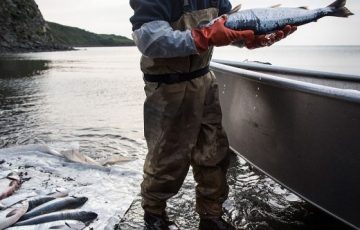 Regulations are in the crosshairs in Washington, D.C. these days. Those elected officials and appointed agency leaders have been clear in their goal to get rid of regulations they say are blocking jobs and economic activity. I humbly suggest that in this flurry to slash red tape, one Environmental Protection Agency protection should stay in place: the one protecting the Bristol Bay fishery in Alaska from the controversial Pebble Mine. I guarantee you the EPA’s plan to restrict mine waste disposal in Bristol Bay waters protects jobs and economic activity: those of my family and the 14,000 others who rely on our nation’s most valuable salmon fishery. In fact, we Alaskans call the sockeye salmon that return to Bristol Bay in their annual spawning runs “red gold.” Bristol Bay is the largest wild salmon fishery remaining anywhere in the world. For thousands of years, those fish have represented not just survival, but wealth. continue reading the op-ed here by Kim Williams 09:08
Regulations are in the crosshairs in Washington, D.C. these days. Those elected officials and appointed agency leaders have been clear in their goal to get rid of regulations they say are blocking jobs and economic activity. I humbly suggest that in this flurry to slash red tape, one Environmental Protection Agency protection should stay in place: the one protecting the Bristol Bay fishery in Alaska from the controversial Pebble Mine. I guarantee you the EPA’s plan to restrict mine waste disposal in Bristol Bay waters protects jobs and economic activity: those of my family and the 14,000 others who rely on our nation’s most valuable salmon fishery. In fact, we Alaskans call the sockeye salmon that return to Bristol Bay in their annual spawning runs “red gold.” Bristol Bay is the largest wild salmon fishery remaining anywhere in the world. For thousands of years, those fish have represented not just survival, but wealth. continue reading the op-ed here by Kim Williams 09:08
Governor Brown’s interference pits her against commercial fisherman
 In an astoundingly ignorant and heavy-handed display of putting urban political correctness ahead of rural jobs, Gov. Kate Brown last week dictated that the citizen members of the Oregon Fish and Wildlife Commission reverse their January decision that gave commercial fishermen a minimally fair share of the Columbia River’s salmon allocation. Addressing commissioners as if they are misbehaving children, Brown told Chairman Michael Finley the commission majority’s acknowledgment of reality is “not acceptable” and that “I expect” the commission to acquiesce to her interpretation of the facts by April 3. Fish and Wildlife Commission members are in an infinitely better position to judge the ineffectiveness of salmon policies than is the governor. Read the Op-ed here 17:03
In an astoundingly ignorant and heavy-handed display of putting urban political correctness ahead of rural jobs, Gov. Kate Brown last week dictated that the citizen members of the Oregon Fish and Wildlife Commission reverse their January decision that gave commercial fishermen a minimally fair share of the Columbia River’s salmon allocation. Addressing commissioners as if they are misbehaving children, Brown told Chairman Michael Finley the commission majority’s acknowledgment of reality is “not acceptable” and that “I expect” the commission to acquiesce to her interpretation of the facts by April 3. Fish and Wildlife Commission members are in an infinitely better position to judge the ineffectiveness of salmon policies than is the governor. Read the Op-ed here 17:03
Experts say BC salmon stocks not diminished by sea lice outbreak for now
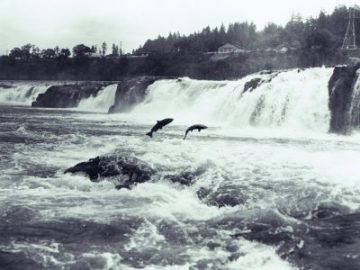 The price of salmon has shot up more than 15 per cent over the last three months, thanks to fish stocks being hit worldwide by an outbreak of sea lice. In Norway and Scotland, two of the world’s largest suppliers of salmon, sea lice outbreaks have made prices rise by a full 50 per cent, coupled with a huge algae bloom in Chile, the world’s second biggest producer of farmed salmon, and global production is down by nine per cent. But the market for Pacific salmon is not likely to see the same price spikes, according to Glen Spain of the Pacific Coast Federation of Fishermen’s Associations, who says that sea lice has so far been less of a scourge for Pacific Coast salmon. The tiny, naturally occurring parasite, found in both wild and farmed salmon, last proved to be a menace on the West Coast in 2015, when infestations were at their highest in five years. Read the story here 07:49
The price of salmon has shot up more than 15 per cent over the last three months, thanks to fish stocks being hit worldwide by an outbreak of sea lice. In Norway and Scotland, two of the world’s largest suppliers of salmon, sea lice outbreaks have made prices rise by a full 50 per cent, coupled with a huge algae bloom in Chile, the world’s second biggest producer of farmed salmon, and global production is down by nine per cent. But the market for Pacific salmon is not likely to see the same price spikes, according to Glen Spain of the Pacific Coast Federation of Fishermen’s Associations, who says that sea lice has so far been less of a scourge for Pacific Coast salmon. The tiny, naturally occurring parasite, found in both wild and farmed salmon, last proved to be a menace on the West Coast in 2015, when infestations were at their highest in five years. Read the story here 07:49
The Surprising Side Effect of Anti-Anxiety Medication — on Salmon
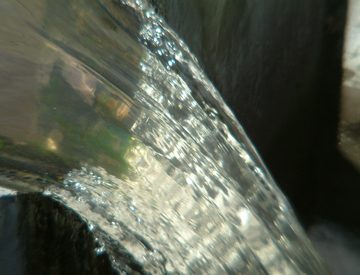 In a study out of Sweden’s Umeå University, researchers show oxazepam — a pharmaceutical prescribed to humans for the treatment of anxiety, alcohol withdrawal, and insomnia — affects the downstream migratory behaviour of Atlantic salmon. Exposing fish to anti-anxiety medication isn’t something that only happens in scientific studies: when humans excrete drugs, some can end up in wastewater effluent and subsequently in sensitive habitats where salmon may get an unintended dose. The researchers found that when fish ingest oxazepam, it makes them migrate faster and farther — potentially recklessly so. Leaving the freshwater nursery and heading out to sea is part of the salmon lifecycle, but landing in the big blue too soon can be risky. Fish may find ocean conditions unfavourable — too cold, too dangerous, or lacking food, for example. Read the story here 14:19
In a study out of Sweden’s Umeå University, researchers show oxazepam — a pharmaceutical prescribed to humans for the treatment of anxiety, alcohol withdrawal, and insomnia — affects the downstream migratory behaviour of Atlantic salmon. Exposing fish to anti-anxiety medication isn’t something that only happens in scientific studies: when humans excrete drugs, some can end up in wastewater effluent and subsequently in sensitive habitats where salmon may get an unintended dose. The researchers found that when fish ingest oxazepam, it makes them migrate faster and farther — potentially recklessly so. Leaving the freshwater nursery and heading out to sea is part of the salmon lifecycle, but landing in the big blue too soon can be risky. Fish may find ocean conditions unfavourable — too cold, too dangerous, or lacking food, for example. Read the story here 14:19
Alaska’s 2016 commercial salmon season harvest down 15 million fish
 New reviews of Alaska’s 2016 commercial salmon season confirm that it was a rough year for the industry, with the overall harvest of 112.6 million fish having an estimated value of $406.4 million. A year ago the combined harvest of all five species of Pacific salmon in Alaska waters came in at 263.5 million fish worth an estimated $414.2 million. Humpies were the real culprit, even in an even year, coming in way below forecast, so that the overall statewide catch of 39.4 million pinks was worth an estimated $37.8 million, compared with 190.5 million pinks worth $132 million a year ago. In overviews released in early November, Alaska Department of Fish and Game confirmed that preliminary ex-vessel value of salmon harvested in Area M totaled $27,730,204 for a commercial harvest of 9.6 million fish, including 15,345 Chinook, 5,981,217 sockeye, 260,922 coho, 2,883,577 pink and 513,338 chum salmon. The ex vessel value information was generated from fish tickets and does not include postseason adjustments paid to fishermen. Read the rest here 14:35
New reviews of Alaska’s 2016 commercial salmon season confirm that it was a rough year for the industry, with the overall harvest of 112.6 million fish having an estimated value of $406.4 million. A year ago the combined harvest of all five species of Pacific salmon in Alaska waters came in at 263.5 million fish worth an estimated $414.2 million. Humpies were the real culprit, even in an even year, coming in way below forecast, so that the overall statewide catch of 39.4 million pinks was worth an estimated $37.8 million, compared with 190.5 million pinks worth $132 million a year ago. In overviews released in early November, Alaska Department of Fish and Game confirmed that preliminary ex-vessel value of salmon harvested in Area M totaled $27,730,204 for a commercial harvest of 9.6 million fish, including 15,345 Chinook, 5,981,217 sockeye, 260,922 coho, 2,883,577 pink and 513,338 chum salmon. The ex vessel value information was generated from fish tickets and does not include postseason adjustments paid to fishermen. Read the rest here 14:35
Poor Ocean Conditions Hit West Coast Fisheries Hard
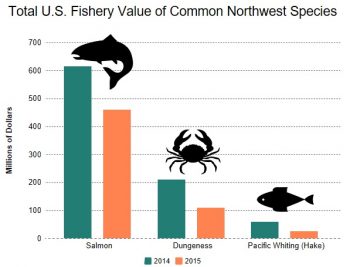 United States commercial fisheries are doing fine overall, but fishermen on the West Coast are hurting. An 2015 annual report out Wednesday from the National Oceanic and Atmospheric Administration shows a stark fall-off in the big seafood money-makers in the Pacific Northwest. Nationally, 2015 was an above average year in terms of catch rate, commercial value and national seafood consumption. “On dinner plates, the average American added nearly an extra pound of seafood,” said Richard Merrick, Chief Scientists of NOAA Fisheries during a call with reporters. But this rise in consumption didn’t really help the Oregon and Washington fishing industry because the crab and fish weren’t there to catch. NOAA Fisheries scientists are attributing the low West Coast returns to abnormal conditions in the Pacific that are linked to climate change. Read the story here 19:11
United States commercial fisheries are doing fine overall, but fishermen on the West Coast are hurting. An 2015 annual report out Wednesday from the National Oceanic and Atmospheric Administration shows a stark fall-off in the big seafood money-makers in the Pacific Northwest. Nationally, 2015 was an above average year in terms of catch rate, commercial value and national seafood consumption. “On dinner plates, the average American added nearly an extra pound of seafood,” said Richard Merrick, Chief Scientists of NOAA Fisheries during a call with reporters. But this rise in consumption didn’t really help the Oregon and Washington fishing industry because the crab and fish weren’t there to catch. NOAA Fisheries scientists are attributing the low West Coast returns to abnormal conditions in the Pacific that are linked to climate change. Read the story here 19:11
Yurok Tribe finds deadly disease in Klamath River salmon
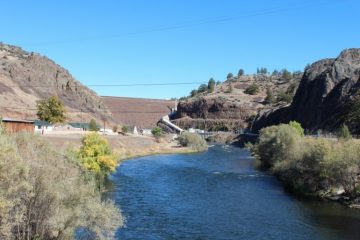 Dan Bacher: The Klamath River salmon fishery, an integral part of the culture, religion and livelihoods of the Yurok, Hoopa Valley and Karuk Tribes of Northern California, is going through some tough times this year. Because of the record-low run of fall-run Chinook salmon projected by federal fishery managers earlier this year, the Yurok Tribe, the largest Indian Tribe in California, held its Klamath Salmon Festival this August without serving traditionally-cooked salmon to the public as it has done for 54 years. Then on August 19, the Tribe announced that Yurok Fisheries crews conducting routine fish disease monitoring have found that salmon in the Klamath River on the Yurok Reservation are infected with a potentially deadly disease. Ichthyophthirius multifiliis, commonly known as ich (pronounced “ick”), is capable of causing large fish kill events, according to the Tribe. Ich was the primary pathogen that caused the 2002 fish kill in the Klamath River and killed more than 35,000 adult Chinook salmon and steelhead after the disease spread in low, warm conditions spurred by Bush administration water policies that favored irrigators over fish and downstream water users. Read the story here 19:22
Dan Bacher: The Klamath River salmon fishery, an integral part of the culture, religion and livelihoods of the Yurok, Hoopa Valley and Karuk Tribes of Northern California, is going through some tough times this year. Because of the record-low run of fall-run Chinook salmon projected by federal fishery managers earlier this year, the Yurok Tribe, the largest Indian Tribe in California, held its Klamath Salmon Festival this August without serving traditionally-cooked salmon to the public as it has done for 54 years. Then on August 19, the Tribe announced that Yurok Fisheries crews conducting routine fish disease monitoring have found that salmon in the Klamath River on the Yurok Reservation are infected with a potentially deadly disease. Ichthyophthirius multifiliis, commonly known as ich (pronounced “ick”), is capable of causing large fish kill events, according to the Tribe. Ich was the primary pathogen that caused the 2002 fish kill in the Klamath River and killed more than 35,000 adult Chinook salmon and steelhead after the disease spread in low, warm conditions spurred by Bush administration water policies that favored irrigators over fish and downstream water users. Read the story here 19:22
Salmon gillnetting to resume Aug. 7 in the Columbia River
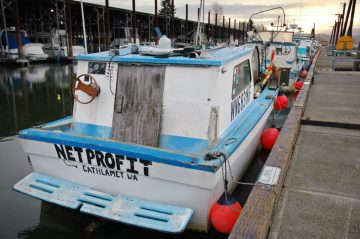 Nine nights of gillnetting in the lower Columbia River between Warrior Rock and Beacon Rock will begin Aug. 7. The commercial fleet will fish Sundays, Tuesdays and Thursdays from 9 p.m. to 6 a.m. through Aug. 26, according to regulations adopted today in Vancouver by the Columbia River Compact. Nine-inch-minimum-mesh nets will be required. Robin Ehlke, assistant Columbia River policy coordinator for the Washington Department of Fish and Wildlife, said the netters are projected to catch 2,200 fall chinook in the first week, 7,500 in the second week and 19,700 in the third week. Read the rest here 10:06
Nine nights of gillnetting in the lower Columbia River between Warrior Rock and Beacon Rock will begin Aug. 7. The commercial fleet will fish Sundays, Tuesdays and Thursdays from 9 p.m. to 6 a.m. through Aug. 26, according to regulations adopted today in Vancouver by the Columbia River Compact. Nine-inch-minimum-mesh nets will be required. Robin Ehlke, assistant Columbia River policy coordinator for the Washington Department of Fish and Wildlife, said the netters are projected to catch 2,200 fall chinook in the first week, 7,500 in the second week and 19,700 in the third week. Read the rest here 10:06
Salmon are rolling into Upper Cook Inlet’s commercial fishery
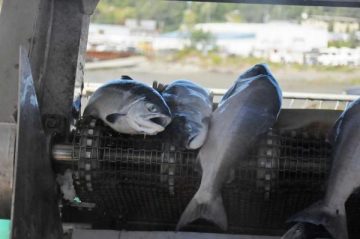 The drift fleet and setnetters in Cook Inlet have been out frequently in the past two weeks and were out for extended hours Thursday. The Alaska Department of Fish and Game also opened the drift gillnet fishery in the Expanded Kenai and Expanded Kasilof Sections of the Upper Subdistrict and the Anchor Point Section of the Lower Subdistrict for an additional 12-hour period on Friday to increase harvest on the sockeye salmon bound for the Kenai and Kasilof rivers, according to an emergency order issued Thursday. The salmon harvest came in just shy of 2 million as of Tuesday, with sockeye leading the pack at 1.6 million, followed by pink salmon at approximately 244,000 fish. Silvers and chum are starting to come in as well, with about 43,000 silvers and about 57,000 chums so far, according to Fish and Game’s inseason harvest estimates. Read the rest here 08:27
The drift fleet and setnetters in Cook Inlet have been out frequently in the past two weeks and were out for extended hours Thursday. The Alaska Department of Fish and Game also opened the drift gillnet fishery in the Expanded Kenai and Expanded Kasilof Sections of the Upper Subdistrict and the Anchor Point Section of the Lower Subdistrict for an additional 12-hour period on Friday to increase harvest on the sockeye salmon bound for the Kenai and Kasilof rivers, according to an emergency order issued Thursday. The salmon harvest came in just shy of 2 million as of Tuesday, with sockeye leading the pack at 1.6 million, followed by pink salmon at approximately 244,000 fish. Silvers and chum are starting to come in as well, with about 43,000 silvers and about 57,000 chums so far, according to Fish and Game’s inseason harvest estimates. Read the rest here 08:27
Alaska Salmon Harvest Nears 5 Million Fish
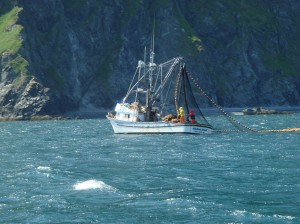 Commercial harvests of Alaska’s wild salmon have expanded statewide, with total deliveries nearing 5 million fish, including nearly 3 million sockeyes. Preliminary harvest figures compiled by the Alaska Department of Fish and Game show that in the westward region, processors in the Alaska Peninsula have received 950,000 humpies, 883,000 sockeyes, 134,000 chums and fewer than 1,000 cohos. At Chignik, the catch reached 334,000 reds, 16,000 chums, 7,000 pinks and 1,000 kings, and at Kodiak 176,000 sockeyes, 63,000 chums, 8,000 pinks and 1,000 kings. In Prince William Sound,,, Read the rest here 10:25
Commercial harvests of Alaska’s wild salmon have expanded statewide, with total deliveries nearing 5 million fish, including nearly 3 million sockeyes. Preliminary harvest figures compiled by the Alaska Department of Fish and Game show that in the westward region, processors in the Alaska Peninsula have received 950,000 humpies, 883,000 sockeyes, 134,000 chums and fewer than 1,000 cohos. At Chignik, the catch reached 334,000 reds, 16,000 chums, 7,000 pinks and 1,000 kings, and at Kodiak 176,000 sockeyes, 63,000 chums, 8,000 pinks and 1,000 kings. In Prince William Sound,,, Read the rest here 10:25
To Save Its Salmon, California Calls in the Fish Matchmaker
 On a frigid morning in a small metal-sided building, a team of specialists prepared to orchestrate an elaborate breeding routine. The work would be wet and messy, so they wore waders. Their tools included egg trays and a rubber mallet, which they used to brain a fertile female coho salmon, now hanging dead on a hook. Diana Chesney, a biologist, studied a piece of paper with a matrix of numbers, each one denoting a male salmon and potential match for the female coho. “This is the bible,” she said of the matrix. “It’s what Carlos says.” Read the article here 12:57
On a frigid morning in a small metal-sided building, a team of specialists prepared to orchestrate an elaborate breeding routine. The work would be wet and messy, so they wore waders. Their tools included egg trays and a rubber mallet, which they used to brain a fertile female coho salmon, now hanging dead on a hook. Diana Chesney, a biologist, studied a piece of paper with a matrix of numbers, each one denoting a male salmon and potential match for the female coho. “This is the bible,” she said of the matrix. “It’s what Carlos says.” Read the article here 12:57
For Lummis, fishing is more than a living — it’s a way of life
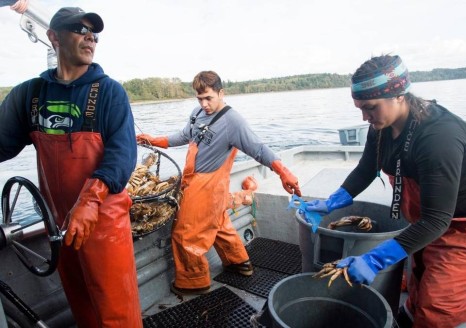 Members of Lummi Nation say that for them, fishing is different. Tribal and nontribal fishers alike must keep to the seasons and mind their catch quotas. Still, for most Washington residents, fishing is a privilege granted by the state government, said Jay Julius, a Lummi member who has a seat on the tribe’s council. The tribe, on the other hand, has been fishing for 150 generations, Julius said. “To us, culture is fish and fish is culture,” he said. “It’s more than a privilege, it’s who we are. “It’s in our DNA.” Read the rest here 13:24
Members of Lummi Nation say that for them, fishing is different. Tribal and nontribal fishers alike must keep to the seasons and mind their catch quotas. Still, for most Washington residents, fishing is a privilege granted by the state government, said Jay Julius, a Lummi member who has a seat on the tribe’s council. The tribe, on the other hand, has been fishing for 150 generations, Julius said. “To us, culture is fish and fish is culture,” he said. “It’s more than a privilege, it’s who we are. “It’s in our DNA.” Read the rest here 13:24
Seine or insane? Switch to new fishing method still clouded by practical questions
 Under a plan by disgraced former Oregon Gov. John Kitzhaber, the beginning of the end of commercial gillnet fishing on the main stem of the Columbia River is little more than a year away, but it’s still not clear if gear banned on the river for decades will ultimately replace gillnets. Oregon and Washington’s advisory group and fishery managers in both states are waiting for new information to be released that could clarify what the impacts of the proposed replacement gear — beach and purse seines — are on Columbia River salmon. Read the rest here 20:02
Under a plan by disgraced former Oregon Gov. John Kitzhaber, the beginning of the end of commercial gillnet fishing on the main stem of the Columbia River is little more than a year away, but it’s still not clear if gear banned on the river for decades will ultimately replace gillnets. Oregon and Washington’s advisory group and fishery managers in both states are waiting for new information to be released that could clarify what the impacts of the proposed replacement gear — beach and purse seines — are on Columbia River salmon. Read the rest here 20:02
What are the fish telling us: the story of the world’s largest wild salmon fishery
 The myth (it was a myth) goes that when Christopher Columbus sailed to the Americas in 1492, he and his crew couldn’t sleep because of the perpetual whack of sea turtles bumping against the hull of their ship. Now, 500 years later, nearly every species of sea turtle is listed as endangered. In fact, so many plants and animals have become endangered or extinct in recent years, that researchers and environmentalists have started referring to it as the sixth mass extinction. Read the rest here 12:38
The myth (it was a myth) goes that when Christopher Columbus sailed to the Americas in 1492, he and his crew couldn’t sleep because of the perpetual whack of sea turtles bumping against the hull of their ship. Now, 500 years later, nearly every species of sea turtle is listed as endangered. In fact, so many plants and animals have become endangered or extinct in recent years, that researchers and environmentalists have started referring to it as the sixth mass extinction. Read the rest here 12:38
Salmon fishing returns to Fukushima after 5-year absence
 Traditional salmon “combination net fishing” returned to the Kidogawa river here for the first time in five years as fishermen hauled in about 120 of the cold-water fish. With the evacuation order for Naraha lifted in September, members of the local fisheries cooperative association gathered around 11:30 a.m. on Oct. 18 to drive salmon from the upper reaches of the Kidogawa with a net toward another one set up downstream. It was the first time the fishing operations took place since,,, Read the rest here 09:21
Traditional salmon “combination net fishing” returned to the Kidogawa river here for the first time in five years as fishermen hauled in about 120 of the cold-water fish. With the evacuation order for Naraha lifted in September, members of the local fisheries cooperative association gathered around 11:30 a.m. on Oct. 18 to drive salmon from the upper reaches of the Kidogawa with a net toward another one set up downstream. It was the first time the fishing operations took place since,,, Read the rest here 09:21
Fish wrap-up – Debriefer: October 14, 2015
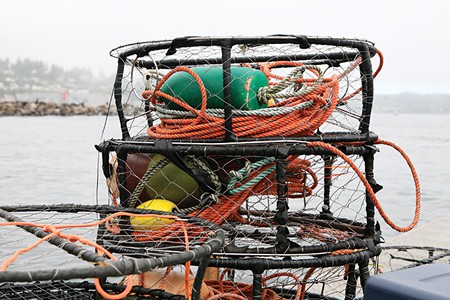 From the Article: U.S. Rep. Jared Huffman co-sponsored the West Coast Dungeness Crab Management Act that seeks to permanently extend a 20-year fisheries management agreement aimed at protecting the health of the crab fishery in . It is set to expire next September. But there’s a longstanding critique of Dungeness management that small-time Bodega Bay operators say puts them at a disadvantage. And speaking of endangered species,,, Read the rest here 08:28
From the Article: U.S. Rep. Jared Huffman co-sponsored the West Coast Dungeness Crab Management Act that seeks to permanently extend a 20-year fisheries management agreement aimed at protecting the health of the crab fishery in . It is set to expire next September. But there’s a longstanding critique of Dungeness management that small-time Bodega Bay operators say puts them at a disadvantage. And speaking of endangered species,,, Read the rest here 08:28
Salmon ‘nightmare’ ahead?
 Oregon and Washington will experience two big El Nino-like events in combination this year, scientists and fishery managers say. This has never happened before and the events could have major impacts on commercial and recreational fisheries — and ocean species from salmon to orcas — for years to come. One of these events is a true El Nino — a big one — and brings with it the likelihood of less precipitation and warmer temperatures in the Pacific Northwest. The other event, the “Blob,” is a warm expanse of water that has persisted off the West Coast for over a year and only resembles El Nino. It is an anomaly, a mystery. Read the rest here 19:59
Oregon and Washington will experience two big El Nino-like events in combination this year, scientists and fishery managers say. This has never happened before and the events could have major impacts on commercial and recreational fisheries — and ocean species from salmon to orcas — for years to come. One of these events is a true El Nino — a big one — and brings with it the likelihood of less precipitation and warmer temperatures in the Pacific Northwest. The other event, the “Blob,” is a warm expanse of water that has persisted off the West Coast for over a year and only resembles El Nino. It is an anomaly, a mystery. Read the rest here 19:59
Feds release extra water to save Klamath salmon from disease
 With water scarce in Northern California’s Klamath Basin, a federal agency is again releasing cool, clean water into the Klamath River to prevent a repeat of the 2002 fish kill that left tens of thousands of adult salmon dead.The U.S. Bureau of Reclamation said releases started Friday from Lewiston Dam on the Trinity River, the Klamath’s primary tributary, and would continue into late September. Similar releases were done the last three years. They come from water that is shared with farms in the Central Valley. “In this fourth year of severe drought,,, Read the rest here 19:54
With water scarce in Northern California’s Klamath Basin, a federal agency is again releasing cool, clean water into the Klamath River to prevent a repeat of the 2002 fish kill that left tens of thousands of adult salmon dead.The U.S. Bureau of Reclamation said releases started Friday from Lewiston Dam on the Trinity River, the Klamath’s primary tributary, and would continue into late September. Similar releases were done the last three years. They come from water that is shared with farms in the Central Valley. “In this fourth year of severe drought,,, Read the rest here 19:54




































